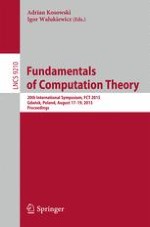2015 | OriginalPaper | Buchkapitel
Complexity of Suffix-Free Regular Languages
verfasst von : Janusz Brzozowski, Marek Szykuła
Erschienen in: Fundamentals of Computation Theory
Aktivieren Sie unsere intelligente Suche, um passende Fachinhalte oder Patente zu finden.
Wählen Sie Textabschnitte aus um mit Künstlicher Intelligenz passenden Patente zu finden. powered by
Markieren Sie Textabschnitte, um KI-gestützt weitere passende Inhalte zu finden. powered by
